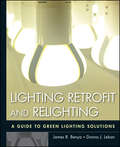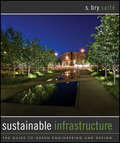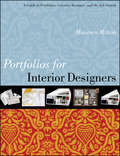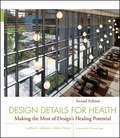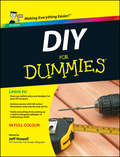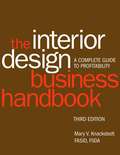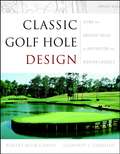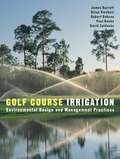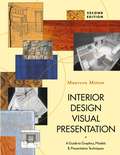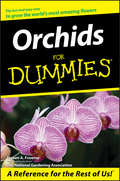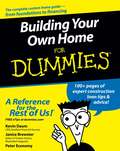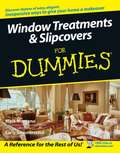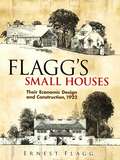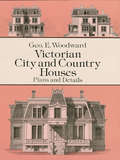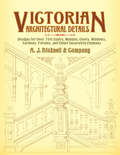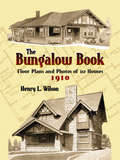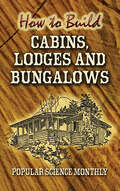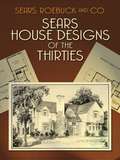- Table View
- List View
Lighting Retrofit and Relighting: A Guide to Energy Efficient Lighting
by James R. Benya Donna J. LebanThe ultimate guide to the retrofitting of lighting for greater efficiency and performance Retrofitting outdated energy-guzzling lighting components with green energy-saving alternatives is a process that promotes sustainability and offers significant benefits for businesses, contractors, and the community at large. Not only can retrofitting improve the overall quality and functionality of light, it also can make spaces safer, easier and less costly to maintain, and more comfortable to inhabit. From lighting technology to retrofit financial analysis, Lighting Retrofit and Relighting evaluates the latest lighting system types, then demonstrates how to apply them for the greatest functional and cost-saving benefit. This book: Discusses the recent advances in lighting equipment and retrofittable controls, for both interior and outdoor use Explains how to do a lighting audit to identify and evaluate logical retrofit choices Includes case studies of retrofits, illustrating improvements in the quality and efficacy of new lighting Demonstrates how cost savings realized over time can not only pay for new equipment but produce a return on the investment Lighting Retrofit and Relighting serves as an ideal reference for students or professionals—whether they are energy auditors, designers, installers, facilities managers, or manufacturers—by taking a close look at the most current lighting technology illuminating pathways toward a brighter future.
Sustainable Infrastructure: The Guide to Green Engineering and Design
by S. Bry SarteAs more factors, perspectives, and metrics are incorporated into the planning and building process, the roles of engineers and designers are increasingly being fused together. Sustainable Infrastructure explores this trend with in-depth look at sustainable engineering practices in an urban design as it involves watershed master-planning, green building, optimizing water reuse, reclaiming urban spaces, green streets initiatives, and sustainable master-planning. This complete guide provides guidance on the role creative thinking and collaborative team-building play in meeting solutions needed to affect a sustainable transformation of the built environment.
Sustainable Infrastructure: The Guide to Green Engineering and Design
by S. Bry SarteAs more factors, perspectives, and metrics are incorporated into the planning and building process, the roles of engineers and designers are increasingly being fused together. Sustainable Infrastructure explores this trend with in-depth look at sustainable engineering practices in an urban design as it involves watershed master-planning, green building, optimizing water reuse, reclaiming urban spaces, green streets initiatives, and sustainable master-planning. This complete guide provides guidance on the role creative thinking and collaborative team-building play in meeting solutions needed to affect a sustainable transformation of the built environment.
Portfolios for Interior Designers: A Guide to Portfolios, Creative Resumes, and the Job Search
by Maureen MittonThe complete guide to portfolio development for interior designers It's a widely known fact that interior designers need a strong visual presence in the form of a well-crafted, professional-looking portfolio. Surprisingly, however, many interior designers aren't equipped with the expertise required to organize and unify their work in a fashion that optimally conveys their talents and skills. Portfolios for Interior Designers helps demystify the process by guiding the reader toward mastery in assembling a winning portfolio. It delivers essential step-by-step instruction presented in a manner that shows interior designers how to properly and effectively display their designs. This book also includes: Color and black-and-white illustrations showing portfolio elements and options Graphic design concepts necessary for portfolio development Specific information for the design of digital portfolios Supplemental teaching resources that direct readers to a companion Web site Useful tips on the ways that popular graphics software applications can be best implemented for certain portfolio elements Samples of cover letters and resumes, along with discussion of job search procedures With the aid of real-world examples, Portfolios for Interior Designers examines how a portfolio can be used as an effective tool for communicating with clients and other professionals. A much-needed guide, this book eliminates the uncertainty surrounding portfolio development so that interior designers can showcase their abilities success-fully—and land the next job.
Portfolios for Interior Designers: A Guide to Portfolios, Creative Resumes, and the Job Search
by Maureen MittonThe complete guide to portfolio development for interior designers It's a widely known fact that interior designers need a strong visual presence in the form of a well-crafted, professional-looking portfolio. Surprisingly, however, many interior designers aren't equipped with the expertise required to organize and unify their work in a fashion that optimally conveys their talents and skills. Portfolios for Interior Designers helps demystify the process by guiding the reader toward mastery in assembling a winning portfolio. It delivers essential step-by-step instruction presented in a manner that shows interior designers how to properly and effectively display their designs. This book also includes: Color and black-and-white illustrations showing portfolio elements and options Graphic design concepts necessary for portfolio development Specific information for the design of digital portfolios Supplemental teaching resources that direct readers to a companion Web site Useful tips on the ways that popular graphics software applications can be best implemented for certain portfolio elements Samples of cover letters and resumes, along with discussion of job search procedures With the aid of real-world examples, Portfolios for Interior Designers examines how a portfolio can be used as an effective tool for communicating with clients and other professionals. A much-needed guide, this book eliminates the uncertainty surrounding portfolio development so that interior designers can showcase their abilities success-fully—and land the next job.
Design Details for Health: Making the Most of Design's Healing Potential (Wiley Series in Healthcare and Senior Living Design #9)
by Cynthia A. Leibrock Debra D. Harris PhD.Praise for Design Details for Health "Cynthia Leibrock and Debra Harris have developed a vitally important reference. They draw upon and compile a rich source of evidence that supports the application of specific research-based details for particular health-related settings."—From the Foreword by Dr. Wayne Ruga, AIA, FIIDA, Hon. FASID The revised edition on implementing design details to improve today's health care facilities—an inspiring, comprehensive guide In this significantly revised second edition, Cynthia Leibrock and Debra Harris offer up-to-date information on design details that can improve patient outcomes and user experience by returning authority to the patient, along with fascinating case studies and research demonstrating the positive role design can play in reducing health care costs. Design Details for Health, Second Edition offers contemporary examples showing how design can improve patient comfort and independence, and demonstrates how to design highly functional health care facilities that operate at peak performance. The book addresses a range of health care facility types including hospitals, ambulatory care, wellness centers, subacute care and rehabilitation, adult day care and respite, assisted living, hospice, dementia care, and aging in place. This Second Edition includes: The latest research, which was only anecdotal in nature as recently as a decade ago, illustrating how design through evidence produces measurable outcomes Real-world case studies of a range of excellent health care facilities that have been designed and built in the twenty-first century Updated contributions with leading practitioners, researchers, and providers conveying how design has a positive impact on health care delivery When design empowers rather than disables, everybody wins. Sensitive to the needs of both patients and providers, Design Details for Health, Second Edition is essential reading for today's architects, interior designers, facility managers, and health care professionals.
Design Details for Health: Making the Most of Design's Healing Potential (Wiley Series in Healthcare and Senior Living Design #9)
by Cynthia A. Leibrock Debra D. Harris PhD.Praise for Design Details for Health "Cynthia Leibrock and Debra Harris have developed a vitally important reference. They draw upon and compile a rich source of evidence that supports the application of specific research-based details for particular health-related settings."—From the Foreword by Dr. Wayne Ruga, AIA, FIIDA, Hon. FASID The revised edition on implementing design details to improve today's health care facilities—an inspiring, comprehensive guide In this significantly revised second edition, Cynthia Leibrock and Debra Harris offer up-to-date information on design details that can improve patient outcomes and user experience by returning authority to the patient, along with fascinating case studies and research demonstrating the positive role design can play in reducing health care costs. Design Details for Health, Second Edition offers contemporary examples showing how design can improve patient comfort and independence, and demonstrates how to design highly functional health care facilities that operate at peak performance. The book addresses a range of health care facility types including hospitals, ambulatory care, wellness centers, subacute care and rehabilitation, adult day care and respite, assisted living, hospice, dementia care, and aging in place. This Second Edition includes: The latest research, which was only anecdotal in nature as recently as a decade ago, illustrating how design through evidence produces measurable outcomes Real-world case studies of a range of excellent health care facilities that have been designed and built in the twenty-first century Updated contributions with leading practitioners, researchers, and providers conveying how design has a positive impact on health care delivery When design empowers rather than disables, everybody wins. Sensitive to the needs of both patients and providers, Design Details for Health, Second Edition is essential reading for today's architects, interior designers, facility managers, and health care professionals.
DIY For Dummies
by Jeff HowellThis hands-on guide will help you prepare for and manage simple home repairs and improvements. Jeff Howell (the Sunday Telegraph's DIY columnist) and a host of other experts guide you through the trials and tribulations of DIY, helping you to carry out a range of projects - from fixing a leaky tap to hanging wallpaper - safely, cheaply and with minimum disruption. The full-colour drawings illustrate the step-by-step techniques and the lay-flat binding is perfect for on-the-job DIY advice. DIY For Dummies covers: PART I - Planning Your Home Improvement Projects Chapter 1: Gearing Up for Your DIY Adventures Chapter 2: Being Safe and Prepared Chapter 3: Working with (And within) a Budget PART II - Basic Home Maintenance and Improvement Chapter 1: Repairing Walls and Putting Up Shelves Chapter 2: Windows Don't Have to Be a Pane Chapter 3: Doors: An Open-and-Shut Case Chapter 4: Roofs and Walls Chapter 5: Dealing with Damp Chapter 6: Electrical Repairs and Replacements PART III - Painting and Wallpapering Chapter 1: Planning Your Painting Project Chapter 2: Preparing Surfaces for Painting Chapter 3: Painting, Finishing, and Cleaning Up Chapter 4: Choosing Wallpaper and Preparing Walls Chapter 5: Hanging Wallpaper PART V - Carpentry, Woodworking, and Flooring Chapter 1: Flooring: Keeping a Leg Up on Foot Traffic Chapter 2: Drilling, Driving, Fastening, and Gluing Chapter 3: Understanding the Carpentry Process Chapter 4: Finishing Wood PART VI - Plumbing Chapter 1: The Plumbing System in Your Home Chapter 2: Heating, Ventilating, and Insulating Your Home Chapter 3: Plumbing Materials and Tools Chapter 4: Unblocking a Sink or Bath Drain Chapter 5: Unblocking and Fixing a Toilet Chapter 6: Fixing a Dripping Tap
DIY For Dummies (For Dummies)
by By Roy Barnhart James Carey Morris Carey Gene Hamilton Katie Hamilton Don R. Prestly Jeff Strong Edited by Jeff HowellThis hands-on guide will help you prepare for and manage simple home repairs and improvements. Jeff Howell (the Sunday Telegraph's DIY columnist) and a host of other experts guide you through the trials and tribulations of DIY, helping you to carry out a range of projects - from fixing a leaky tap to hanging wallpaper - safely, cheaply and with minimum disruption. The full-colour drawings illustrate the step-by-step techniques and the lay-flat binding is perfect for on-the-job DIY advice. DIY For Dummies covers: PART I - Planning Your Home Improvement Projects Chapter 1: Gearing Up for Your DIY Adventures Chapter 2: Being Safe and Prepared Chapter 3: Working with (And within) a Budget PART II - Basic Home Maintenance and Improvement Chapter 1: Repairing Walls and Putting Up Shelves Chapter 2: Windows Don't Have to Be a Pane Chapter 3: Doors: An Open-and-Shut Case Chapter 4: Roofs and Walls Chapter 5: Dealing with Damp Chapter 6: Electrical Repairs and Replacements PART III - Painting and Wallpapering Chapter 1: Planning Your Painting Project Chapter 2: Preparing Surfaces for Painting Chapter 3: Painting, Finishing, and Cleaning Up Chapter 4: Choosing Wallpaper and Preparing Walls Chapter 5: Hanging Wallpaper PART V - Carpentry, Woodworking, and Flooring Chapter 1: Flooring: Keeping a Leg Up on Foot Traffic Chapter 2: Drilling, Driving, Fastening, and Gluing Chapter 3: Understanding the Carpentry Process Chapter 4: Finishing Wood PART VI - Plumbing Chapter 1: The Plumbing System in Your Home Chapter 2: Heating, Ventilating, and Insulating Your Home Chapter 3: Plumbing Materials and Tools Chapter 4: Unblocking a Sink or Bath Drain Chapter 5: Unblocking and Fixing a Toilet Chapter 6: Fixing a Dripping Tap
The Interior Design Business Handbook: A Complete Guide to Profitability
by Mary V. KnackstedtDiscover how you can run the practical side of your practice more profitably. This comprehensive guide to managing an interior design business gives you an arsenal of proven procedures and practical tools and techniques perfected over the course of some thirty years. New to this edition are sections on establishing an electronic office, the pros and cons of working alone and creating partnerships, hiring and working with off-site employees, and more. It also includes more than fifty sample forms and letters, such as an existing conditions survey and a letter of transmittal, that can easily be adapted to your own uses.
Building Systems for Interior Designers
by Corky BinggeliThe first desk reference on technical building systems for interior designers Building Systems for Interior Designers is the first book to explain technical building systems and engineering issues in a clear and accessible way to interior designers. The technical knowledge and vocabulary presented here allow interior designers to communicate more effectively with architects, engineers, and contractors while collaborating on projects, leading to more accurate solutions for problems related to a broad range of other building considerations with an impact on interior design. Information on sustainable design is integrated throughout the book, making it a relevant tool for current and emerging trends in building design. Written in a straightforward, nontechnical style that maintains depth and accuracy, this book is the first complete text applicable to interior design courses and provides thorough preparation for the NCIDQ exam. Engaging, clear illustrations support the text, which is accessible to those without a math or physics background. Topics covered include: Heating and air conditioning systems Environmental issues Water and waste Thermal comfort HVAC systems Electricity Lighting Security and communications systems Fire safety Transportation systems With numerous case examples illustrating how interior designers apply this material in the real world, Building Systems for Interior Designers is a valuable book for students, as well as a practical desktop reference for professionals. Content from this book is available as an online continuing professional education course at http://www.wiley.com/WileyCDA/Section/id-320255.html#fire_safety. WileyCPE courses are available on demand, 24 hours a day, and are approved by the American Institute of Architects.
Classic Golf Hole Design: Using the Greatest Holes as Inspiration for Modern Courses
by Robert Muir Graves Geoffrey S. CornishGolf course construction continues to burgeon in the United States, Asia, and around the world. This book meets the needs of practicing landscape architects and other practicing professionals involved in the design or re-design of golf courses. Each classic hole is described in terms relevant to the designer including its basic design, its maintenance, and its impact on the golfer's game. Three samples accompany each classic hole illustrating varying replications and how those replications were appropriated for the new course. Graves and Cornish are two of the most famous and respected golf course architects in the United States, who have designed or remodeled a combined 1,000+ courses, taught more than 60 seminars on golf course design, and are both past presidents of the American Society of Golf Course Architects.
Golf Course Irrigation: Environmental Design and Management Practices
by James Barrett Brian Vinchesi Robert Dobson Paul Roche David ZoldoskeComplete guidelines to developing and maintaining the most effective, environment-friendly irrigation systems for golf courses Golf Course Irrigation offers valuable insight on the design, installation, management, and maintenance of irrigation systems-the most important management tool used on today's golf courses. Without manufacturers' bias, this useful resource provides hands-on guidance to the highest quality irrigation systems, including specifications and applications of the best pump stations, controllers, sprinkler heads, nozzles, valves, sensors, and other components that make the difference in top-quality irrigation systems. Typically regarded as significant users of water, golf courses are under increasing scrutiny by governmental and environmental groups, making it essential that the up-to-date information found here-on such topics as water supply, plant irrigation requirements, application uniformity, and construction management-be at the fingertips of every golf course professional. While fostering the best playing conditions, these systems conserve water and energy with such technology as low-pressure heads and controls that use "if/then" logic to automatically adjust to changing conditions, which can improve playability while saving money. Golf Course Irrigation is a practical tool to help golf course architects, builders, superintendents, irrigation consultants, designers, and installers to improve aesthetics and playing conditions in the face of diminishing natural resources. It is also an informative reference for golf course owners, developers, local officials, students, and fans of the game.
Interior Design Visual Presentation: A Guide to Graphics, Models, and Presentation Techniques
by Maureen MittonThe new, updated edition of the successful book on interior design Interior Design Visual Presentation, Second Edition is fully revised to include the latest material on CAD, digital portfolios, resume preparation, and Web page design. It remains the only comprehensive guide to address the visual design and presentation needs of the interior designer, with coverage of design graphics, models, and presentation techniques in one complete volume. Approaches to the planning, layout, and design of interior spaces are presented through highly visual, step-by-step instructions, supplemented with more than forty pages of full-color illustrations, exercises at the end of each chapter, and dozens of new projects. With the serious designer in mind, it includes a diverse range of sample work, from student designers as well as well-known design firms such as Ellerbee and Beckett Architects and MS Architects.
Orchids For Dummies
by Steven A. Frowine National Gardening AssociationPacked with photos, including 8 pages in full color Color your world with orchids Orchids are beautiful, fragrant, wonderfully varied, and surprisingly affordable. But aren't they hard to grow at home? No! says orchid grower extraordinaire Steve Frowine. In this handy guide, he shows you step by step how to select the right orchids, keep them healthy, encourage blooms, and even propagate your own plants. Discover how to: * Select orchids that will thrive in your home * Water, fertilize, repot, and propagate orchids * Decipher complicated orchid names * Get familiar with favorite orchid varieties * Create spectacular orchid displays
Building Your Own Home For Dummies
by Kevin Daum Janice Brewster Peter EconomyKeep construction on track with helpful checklists Turn your dream of a custom home into reality! Thinking about building your own home? This easy-to-follow guide shows you how to plan and build a beautiful home on any budget. From acquiring land to finding the best architect to overseeing the construction, you get lots of savvy tips on managing your new investment wisely -- and staying sane during the process! Discover how to: * Find the best homesite * Navigate the plan approval process * Obtain financing * Hire the right contractor * Cut design and construction costs * Avoid common mistakes
Window Treatments and Slipcovers For Dummies
by Mark Montano Carly SommersteinGain inspiration from 8 pages of full-color photos Create a stunning room with dozens of step-by-step projects Want to ditch your drab drapes and so-so slipcovers and create a style that's uniquely your own? Top designer Mark Montano reveals how easy it is to jazz up your windows and furniture -- without breaking the bank! You get expert tips on everything from measuring and cutting material to accessorizing, as well as savvy shortcuts and quick fixes. Discover how to * Express your individual style * Choose fabrics, trims, and hardware * Ensure the perfect fit * Create no-sew or low-sew treatments * Add decorative details
Flagg's Small Houses: Their Economic Design and Construction, 1922
by Ernest FlaggA celebrated New York architect and designer of the city's fabled Singer Building, Ernest Flagg (1857-1947) was most famous for his skyscrapers. But Flagg was also an ardent proponent of the well-designed single-family dwelling. As this classic treatise illustrates, he devised a variety of structural economies and ingenious innovations.Filled with 526 blueprints, photographs, and other illustrations, Flagg's Small Houses embraces modular designs, the use of ridge-dormers, and saving space, materials, and costs. Flagg offers advice on every corner of the home, from the practicalities of plumbing and heating to the aesthetics of color choices and landscaping designs. Modern designers, both professional and amateur, will find this book a timeless source of advice and inspiration.
Authentic Color Schemes for Victorian Houses: Comstock's Modern House Painting, 1883
by E. K. Rossiter F. A. WrightWhen the authors, a pair of respected architects, first published this beautiful book in the late Victorian era, they meant it as a wakeup call to the forward-looking homeowners of the time — inviting them to eschew "the old puritanical hatred of color, which found its natural outcome in white houses with green blinds" and join in the revolutionary trend toward "advanced notions, in which the more positive colors find a chance of expression." The book helped homeowners to attain this goal through its presentation of full-color illustrations of attractive, up-to-date color schemes for houses, with special attention given to the refined lines of Queen Anne-style homes.The heart of the book is the section of 20 exquisite color plates — each reproducing a flawlessly executed architectural drawing that shows the color possibilities for a specific house, and each accompanied by an extensive written description of the colors to be used for exterior walls and trim. An informative introductory section gives a clear explanation of how to mix primary and secondary colors to achieve such popular, mellow tones of the period as olive, russet, citrine, buff, plum, and sage. This authentic source of inspiration and suggestions will be prized by restorationists, architects, home-builders, and lovers of Victoriana.
Victorian City and Country Houses: Plans and Details
by Geo E. WoodwardThe widespread interest in constructing and restoring Victorian homes makes this a must-have volume for today's builders, homeowners, architects, and preservationists. It offers an abundance of authentic, finely detailed plans and designs for a variety of Victorian residences.Included are 100 front and side elevations, floor plans, and original designs -- all to working scale -- for a block of five city houses, a country house with a French roof, a summer house, various styles of cottages, a tool house, and other buildings. The plates also depict a wealth of details: roof and dormer windows, balustrades, iron fences and gates, finials, crestings, gables, brackets, paneling, mantels, front doors, an oriel window, chimneys, and many other elements.Republished directly from a rare 1877 edition, the book offers a wonderfully authentic look back to the distinctive building styles of the Victorian period. It will not only delight builders and restorationists, but any student or lover of period architecture.
Victorian Architectural Details: Designs for Over 700 Stairs, Mantels, Doors, Windows, Cornices, Porches, and Other Decorative Elements
by A. J. Bicknell Co.Hundreds of rare illustrations depict wide range of design alternatives for prospective homeowners and other customers of the late 19th century. While the collection includes elevations and floor plans for a variety of handsome, private residences and commercial structures, the emphasis is on architectural details — from dormer windows to balconies.
The Bungalow Book: Floor Plans and Photos of 112 Houses, 1910
by Henry L. WilsonCozy, charming, and distinctly Californian, the bungalow is an enduring architectural icon. Originally designed to survive earthquakes, the low, rambling structures combined grace, beauty, and comfort at minimum cost.Early in the twentieth century, Los Angeles architect Henry Wilson, who called himself "The Bungalow Man," compiled 112 of the most popular and economic bungalow blueprints of his time in a catalog for would-be homeowners. Complementing each set of prints was an illustration or photograph of the completed house, which most frequently contained two or three bedrooms with closet space, living and dining rooms, a kitchen with pantry, and a bath.An ideal reference for preservationists and restorers, this reprint of Wilson's rare catalog represents a wonderful time capsule and invaluable guide to a popular style of American domestic architecture.
Sears Modern Homes, 1913 (Dover Architecture Ser.)
by Roebuck Sears Co.For thousands of Americans, catalogs such as Sears' Modern Homes were the first step in realizing their dreams of owning a home. Reproduced from a rare 1913 edition, this volume features 112 designs for homes of "comfort and refinement." These authentic plans offer a wealth of information on building materials and other details, along with external views, floor plans, descriptions with prices, and more. Antique collectors, home hobbyists, and fans of traditional design will find this book a bountiful resource for valuable tips on building and restoration.
How to Build Cabins, Lodges and Bungalows
by Popular Science Monthly"Nothing could be more American than the simple cabin. Not many generations ago, it was the backbone of American life, the headquarters of that important unit, the home. It provided shelter, protection, and a foundation upon which to build a great empire. The pioneer cabin was, in other words, a necessity." -- From the IntroductionOnce regarded as a safe haven and a vital source of security, the little cabin in the country is today more closely associated with leisurely activities -- a vacation spot and even a health investment. First published in the 1930s, this helpful guide was designed to provide vacation home builders with all the information they needed to construct, decorate, and furnish a rustic little cottage. Floor plans and outlines of necessary materials are included, as are tips on constructing foundations, porches, doors, windows, fireplaces, and other structural elements. There are even suggestions for furnishing and beautifying your cabin.A useful how-to manual, offering straightforward advice on the building process from foundation to roof, this practical book can also be enjoyed as an entertaining look at lifestyle elements of the early twentieth century.
Sears House Designs of the Thirties (Dover Architecture Ser.)
by Roebuck Sears Co.Proudly promoting itself as "the largest home building organization in the world," Sears, Roebuck and Company advertised in 1932 products in a handsome catalog that also displayed a full-size replica of Mount Vernon, created from Sears materials for a Paris exposition in 1932.At the heart of this now-rare publication were measured floor plans for 68 Sears homes. Over 200 illustration displayed interiors and exteriors for such handsome residences as the Belmont, a six-room house with vestibule, breakfast alcove, three bedrooms, and one-and-a-half baths; and the Dover, an English-styled cottage with a massive chimney and unusual roof lines. Photographs of some interiors revealed a furnished living room with paneled side walls and hewed oak ceiling beams; a spacious kitchen with contemporary appliances; a 60-foot living room with a huge stone fireplace, built-in bookshelves, a vaulted ceiling, and other designs.An invaluable sourcebook for restorationists, this handsome volume will also be of use to people interested in preserving homes of the period. It will be welcomed by anyone who relishes a glimpse of America's architectural past.
